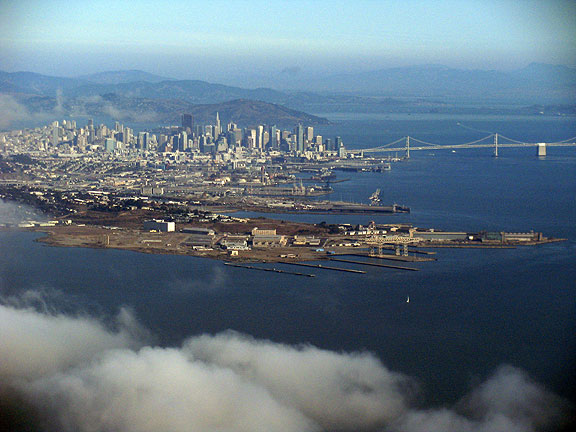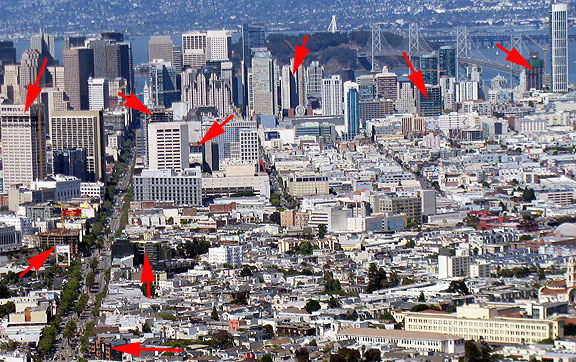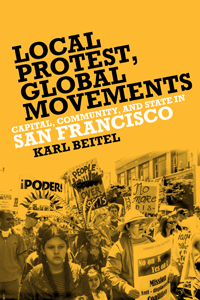Recent Posts
-
Real Crimes and the Coming Violence
September 6, 2025
-
Whither Modern Life?
June 27, 2025
-
What the Hell
June 18, 2025
-
As Darkness Engulfs Us
April 6, 2025
-
AI, Risk, and Work
January 17, 2025
-
“Things Are in the Saddle, and Ride Mankind”
December 29, 2024
-
Forgotten Futures in Seattle
December 12, 2024
-
Autocracy Defeats Neoliberalism
November 14, 2024
-
History… We’re Soaking in It!
October 2, 2024
-
A Numbing Spectacle
September 22, 2024
|
 Taking off in the fog and suddenly there was the city! Just finished a whirlwind visit to New York City where I saw old friends and popped in to visit four separate historical museums. I got extremely lucky with the weather: sunny and high 70s with a nice breeze the whole time I was in town. It was a bit of an odd trip, scheduled at the last minute to send Adriana off to her month at Blue Mountain Center (where I’ve been myself twice previously—an incredible experience of generosity and support for writers) and to prevent losing about 30,000 about-to-expire miles on one of the frequent flyer programs I’m enrolled in.
Since I’m off to Berlin at the end of October for a “History From Below” conference of DIY historians, I thought I should do some extra research in New York in preparation for that confab. I’ll talk about what I saw in the order I did them in, starting with the City Museum of New York’s exhibit on “Activist New York,” then the Museum of the Chinese in America in Chinatown, then the Tenement Museum on Orchard Street in the Lower East Side, and finally the recently opened Museum of Reclaimed Urban Space in the East Village.
 Like San Francisco, there’s a frenzy of building in New York too, the global city saga… With all the work I’ve been doing over the years with Shaping San Francisco and our archive at Foundsf.org, I have thought a lot about how to present historical information. But I can’t honestly say I’ve settled on any particular formula that feels like it always works. Sometimes I want great depth and complexity, other times a photo essay tells the story best, and then there are times when an oral history clip, either video or audio, can really bring a story to life. Other times such clips can be weirdly trivial and uninteresting, so there’s not a sure-fire way to approach these things.
Similarly, there’s been a discussion about a Museum of the City of San Francisco going on for years now. The project as it is so far constituted is controlled by the San Francisco Museum and Historical Society (though I’ve heard rumors that they may be breaking it apart again after some five or maybe even 10 years of not succeeding as a shotgun marriage) and is projected to open someday at the Old Mint at 5th and Mission. But the SFMHS has not been able to advance the project beyond the drawing board and some elaborate but unrealized plans drawn up by well-paid consultants. Having seen the plans going back some years now, I was never very excited about what they were going to do, and definitely wondered about how well it would work, how likely it would be to engage and provoke people to think historically, or might it not be just another cable-car-and-sourdough-bread-on-the-Golden-Gate-Bridge disneyfied history?
Meanwhile, Richard Everett and Amy Hosa at the San Francisco National Maritime Museum have created a marvelous mini-museum of San Francisco history, called “The Waterfront” (free and open to the public at the Visitor Center in the corner of the Argonaut Hotel at Jefferson and Hyde), which does a fine job of telling the central story of San Francisco’s rise and development along its waterfront, which encompasses a great deal of the City’s basic economic and social history as a result. I actually wonder why we need another history museum, even though I can imagine many more historical threads to unwind in other narratives. In any case, my skepticism notwithstanding, I often find museums flat and dull and pointless, if not actively reinforcing the worst clichés and falsehoods that tend to pass for history in our amnesiac society. That I found “The Waterfront” so engaging and well-informed, informative and smart, saved the idea of museums for me, to some extent.
 yeah, I admit it… So in New York I went out looking at these four different institutions to see what I would learn from them, both in terms of the histories they’re presenting, but also how they’re presenting them, how they’re engaging in basic historiography. A good friend told me about the “Activist New York” exhibit after he visited it a month ago and I went hoping to find it inspiring. But something about it went flat for me soon after I started wandering through it. It’s all in one big room, divided into more than a half dozen alcoves. In each there are artifacts, huge photos on the walls, displays highlighting characters who participated in the movements being documented, and small kiosks in the middle of the floor where you can connect to current organizations still campaigning on similar issues. There was a section on women’s rights and suffrage, a section on the proletarian literature movement of the 1930s, the labor movement through the years, the gay and lesbian and transgender movement, the bicycling movement of the past few decades, the urban and architectural preservation movement (with a focus on fighting Robert Moses in NYC), and of course the Civil Rights movement and its connection to the original abolitionists; there was even a display on the “Conservative Party of New York” and its so-called activism. Continue reading Hightailing (and Highlining) it through History in New York
 These red arrows only capture some of the construction frenzy underway now in San Francisco. San Francisco is nearly at full boil. Rampant eviction and displacement, combined with a nearly unprecedented frenzy of new construction, and a wild west of new restaurants, boutiques, and other establishments opening and closing like a spinning top, is changing the face of the city so rapidly that it’s becoming unrecognizable even to those of us who have lived here for decades. Hardly a day passes without news of another friend losing their home to a new buyer who is determined to evict either using “owner move-in” or the state “Ellis Act” which allows owners to leave the rental business and clear their buildings.
 My last friends in the Haight evicted last month.  LisaRuth suffering the indignity of an “owner move-in” and her displacement…. Curiously, thousands of apartments are estimated to be lying empty in San Francisco, held as investments by distant speculators. Thousands more lay unused by the elite who maintain empty apartments in so-called “global cities” spanning the world, pied-a-terre’s for the 1% who drop in once and a while for fun or business. Many more homes have been informally converted into temporary tourist dwellings via the latest dotcom scourge AirBnB, and similar predatory neoliberal business models masquerading as “the sharing economy.”
San Francisco progressives, once known as the Left, but today a bit too compromised and confused to earn consistently even that tepid moniker, are a paper tiger, unable to contest or even slow down the onslaught ripping the fabric of the city. The long-term demise of organized labor, holding on for dear life among city workers, transit workers, and some hotels and the building trades, is an important part of the shrinking of social opposition, but it goes a lot further than that. In the first dotcom boom-and-bust in 1999-2000 a spirited movement emerged, centered in the Mission District and with activist pressure showing up in most parts of town, but an equivalent effort at contestation has simply not appeared this time around. Protests echoing the decade-ago efforts have not drawn the numbers or the attention in 2013; the fact that gentrification has proceeded stealthily and steadily all these years has already radically altered the demographics of the city. Thousands of wealthy people are now living in new condominiums in the South of Market, downtown, Mission Bay, the Haight-Ashbury, the Fillmore, and the Mission District. Thousands of old Victorians have been bought and removed from the rental market, now owned by the burgeoning population of well-paid lawyers, financial analysts, medical and biotech workers, and of course the much-blamed tech workers of the social media empires.
 Trying to make sense of the trajectory from the much-heralded Left Coast City of the past to the increasingly brutal neoliberal cauldron of today is difficult, but two new books published this year offer complementary analyses that help start the introspection. Karl Beitel’s Local Protest, Global Movements: Capital, Community, and State in San Francisco (Temple University Press, Philadephia: 2013) and Jason Henderson’s Street Fight: The Politics of Mobility in San Francisco (Univ of Massachusetts Press, Boston: 2013) both set out to analyze the state of progressive politics, albeit from different points of focus (I should say that I consider each of these authors my friend, too). Trying to make sense of the trajectory from the much-heralded Left Coast City of the past to the increasingly brutal neoliberal cauldron of today is difficult, but two new books published this year offer complementary analyses that help start the introspection. Karl Beitel’s Local Protest, Global Movements: Capital, Community, and State in San Francisco (Temple University Press, Philadephia: 2013) and Jason Henderson’s Street Fight: The Politics of Mobility in San Francisco (Univ of Massachusetts Press, Boston: 2013) both set out to analyze the state of progressive politics, albeit from different points of focus (I should say that I consider each of these authors my friend, too).  Beitel hails from a more traditionally left perspective, and he’s trying to reconcile the history of mass movements and political parties with an eco-Marxist perspective in his focus on housing politics in San Francisco from the 1970s to the mid-2000s. Henderson is a critical geographer teaching at SF State and his book focuses in on the transportation realm, identifying three ideological poles (conservative, neoliberal, and progressive) that have confronted and compromised with each other to create the stalemate we face daily, leaving everyone dissatisfied whether motorist, bus rider, bicyclist, or pedestrian. Beitel hails from a more traditionally left perspective, and he’s trying to reconcile the history of mass movements and political parties with an eco-Marxist perspective in his focus on housing politics in San Francisco from the 1970s to the mid-2000s. Henderson is a critical geographer teaching at SF State and his book focuses in on the transportation realm, identifying three ideological poles (conservative, neoliberal, and progressive) that have confronted and compromised with each other to create the stalemate we face daily, leaving everyone dissatisfied whether motorist, bus rider, bicyclist, or pedestrian.
Both of these slim volumes provide great histories: Beitel highlights the early history of resistance to redevelopment and highrises and how that led to the inadequate-but-better-than-nothing rent control that passed in 1979 (and we still have now, strengthened in subsequent years by savvy ballot-box efforts led by the SF Tenants Union). In a later chapter he recounts the rise of the Mission Anti-displacement Coalition (MAC) and its relationship to the Willie Brown era of unrestrained for-profit building during the first dot-com boom (which really is still ongoing, we now know). Henderson usefully tells the story of the original Freeway Revolt in the 1950s-60s and shows how the coalition that stopped the road builders then was as much conservative as progressive. In a later chapter he gives a great history of the 2nd Freeway Revolt of the 1990s that took place in the wake of the 1989 Loma Prieta earthquake and the opportunity it presented to tear down the Embarcadero and Central freeways. He shows how progressive activists came to accept neoliberal arguments about profitable real estate opportunities as a way to forge an alliance against the conservatives who insisted the city government bolster and expand automobility by repairing the damaged freeways.
These two books, which often parallel each other in interesting ways, also demonstrate one of the problems they’re describing: the isolation of local-issue campaigns from one another. They also both demonstrate the problem of academic theses, that the focus must always be narrowed to an acceptable topic at the expense of a more comprehensive and complex approach. The book market in general is in trouble, and broad analytical works are growing harder to find. Publishers, even academic ones, seem to prefer the easily categorized topical treatments—in this way political writings mirror the separations that political movements keep reproducing, at least in the U.S. Continue reading Life in a Neoliberal Crockpot
I’m cross-posting this, which I also put on the San Francisco Critical Mass blog page.
 June 2013 Critical Mass on Larkin in Civic Center. It’s the last Friday of July, 2013, and of course San Francisco’s Critical Mass will be rolling around 6:30 or so from Justin “Pee-Wee” Herman Plaza, as it has for the past 20 and a half years. I’m not going today, but it’s not because I don’t generally still show up and usually enjoy myself, but because I’m doing something else at the same time that I bought tickets for.
As it happens this is the same week that Joe Eskenazi’s article “Critical Mass Goes Round and Round” appeared in the SF Weakly. I’ve had a few friends wonder what my take on it is, since he attempts to summarize the political impact of 20 years of Critical Mass in the context of bicycling politics and city transit priorities more generally. I’m also quoted in the piece a few times, a product of an hour I spent speaking with Joe a month ago or so.
 Another “circling up” at Mission and South Van Ness in June 2013. I don’t love having a complex set of ideas and experiences reduced to a few out-of-context soundbites that just serve to reinforce my apparent disconnectedness from what matters in terms of the realpolitik of San Francisco. But that’s what mainstream journalism, even or especially in an alt-weekly, will do. Overall I don’t think he did a bad job of capturing the current malaise that besets Critical Mass (a malaise that is only visible to those of us who have long harbored more ambitious hopes for radical social change), and I think he was spot-on in highlighting the severe limits of the narrow corporatist agenda of the SF Bicycle Coalition, both in terms of its self-proclaimed successes and in terms of the actual state of things on the ground in San Francisco for bicyclists.
 Parents still bring kids to the ride regularly. Critical Mass, of course, is not an organization, and thus has no agenda, and never did. One of the originating impulses for it was the experience many of us had of so commonly being treated as second-class citizens on the roads by motorists and by the shape of the infrastructure itself. Eskenazi suggests that our early years’ “success” was to insinuate into the DNA of the city’s people the awareness that cyclists are here and deserve accommodation. I think that’s basically true. But for me, Critical Mass was always about a lot more than mere bicycling. As he rather drippingly notes, I lament that the SFBC and its gov’t allies “have no particular problem with wage labor,” and they are narrowly focused on simply “getting more people on bicycles.” Bicycling is great for all kinds of intrinsic reasons, but bicycling per se is simply not enough.
Indeed, the bicycle for me was always a transportation choice that was obviously superior to other choices, but insofar as we gathered en (Critical M)asse, it quickly became obvious that much more is at stake. Our paucity of public space and opportunity to gather and meet and discuss anything publicly without being subjected to the endless imperative to buy something immediately rose to the foreground as an important element of why Critical Mass mattered.
 Fell street in June 2013 In our book “Shift Happens! Critical Mass at 20” we gathered essays from two dozen contributors spread across the world’s cities showing how Critical Mass spread far and wide and repeatedly changed those cities where it appeared in similar ways. As Eskenazi notes, I wrote in my opening essay in that volume that I’d seen a kind of “life cycle” of Critical Mass in different places, usually involving the hopeful, utopian, and open-ended experience that has captivated so many of us lasting about 5 years, give or take. After that the animating spirits of that “golden era” often turn to other ways to pursue their hopes and goals, whether by launching more mainstream advocacy organizations, turning to other activities entirely such as urban agriculture or free software (just as often, of course, activists from those arenas had joined with other cyclists to spur on Critical Mass from its inception, whether in Brazil or Mexico or Italy or Hungary), or beginning DIY skill-sharing “bike kitchens.”
The spate of horizontalist social movements that are continuing to erupt suddenly across the planet, most recently in Brazil, Turkey, Bulgaria, and Egypt, often find Critical Mass cyclists at the heart of those upheavals. This is not to credit CM with being the necessary precursor or essential causal agent, just to note that our shared experiences in making Critical Mass in over 400 cities around the world during the last two decades has already profoundly affected how we think about and engage in politics, civil society, urban planning, and much more. Continue reading What is Relevance?
|
Hidden San Francisco 2nd EDITION!

NEW 2nd EDITION NOW AVAILABLE!
Buy one here
(Pluto Press, Spring 2025)
|























